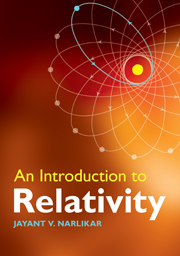Book contents
- Frontmatter
- Contents
- Preface
- 1 The special theory of relativity
- 2 From the special to the general theory of relativity
- 3 Vectors and tensors
- 4 Covariant differentiation
- 5 Curvature of spacetime
- 6 Spacetime symmetries
- 7 Physics in curved spacetime
- 8 Einstein's equations
- 9 The Schwarzschild solution
- 10 Experimental tests of general relativity
- 11 Gravitational radiation
- 12 Relativistic astrophysics
- 13 Black holes
- 14 The expanding Universe
- 15 Friedmann models
- 16 The early Universe
- 17 Observational cosmology
- 18 Beyond relativity
- References
- Index
18 - Beyond relativity
Published online by Cambridge University Press: 05 June 2012
- Frontmatter
- Contents
- Preface
- 1 The special theory of relativity
- 2 From the special to the general theory of relativity
- 3 Vectors and tensors
- 4 Covariant differentiation
- 5 Curvature of spacetime
- 6 Spacetime symmetries
- 7 Physics in curved spacetime
- 8 Einstein's equations
- 9 The Schwarzschild solution
- 10 Experimental tests of general relativity
- 11 Gravitational radiation
- 12 Relativistic astrophysics
- 13 Black holes
- 14 The expanding Universe
- 15 Friedmann models
- 16 The early Universe
- 17 Observational cosmology
- 18 Beyond relativity
- References
- Index
Summary
We have come to the end of our account of the theories of relativity: special and general. While the former was briefly reviewed in the first chapter, we spent 16 chapters presenting the general theory from scratch. After preparing the background of vectors and tensors in the curved spacetime, we introduced the notions of parallel propagation, covariant differentiation, spacetime curvature and symmetries of motion. We then introduced physics through the notions of the action principle and energy-momentum tensors.
This was the appropriate stage to introduce the basics of general relativity: the principle of equivalence, Einstein's field equations and their Newtonian limit. Following these notions, we introduced the Schwarzschild solution and the various tests of general relativity, largely within the Solar System. We also discussed the budding field of gravitational radiation and the attempts to detect it coming from cosmic sources. Our next topic was relativistic astrophysics, which deals with compact massive objects such as supermassive stars and black holes. We also briefly touched upon the very interesting topic of gravitational lensing. This was followed by a discussion of some highlights of relativistic cosmology.
This presentation is indicative of the scope of general relativity. While it has created a niche for itself in theoretical physics as a remarkable intellectual exercise, it has also justified its status as the most effective physical theory of gravitation by explaining and predicting several gravitational phenomena.
Information
- Type
- Chapter
- Information
- An Introduction to Relativity , pp. 334 - 352Publisher: Cambridge University PressPrint publication year: 2010
